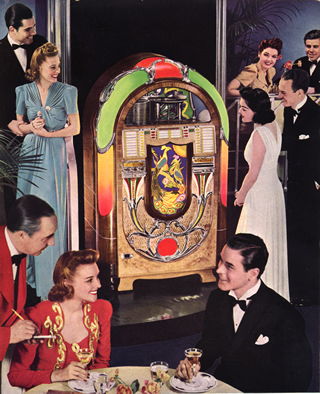The Box that Rocks
Before Napster, Facebook, YouTube, and musical ring tones allowed the music obsessed to share their favorite songs with friends, strangers, and even enemies, Americans turned to the jukebox.
They still do.
When the doorbell rings at Cassendre de le Fortrie and Dennis Lynch’s Eichler home in the city of Orange—and they’re not expecting anyone—they know just what to expect.
 |
|
|
 |
|
|
 |
|
|
Standing at their door will be jiving jukebox fans dying to hear their AMI Continental, topped with a flying saucer-like wing.
“It is literally like we have friends show up at our door to show their friends Dean Martin’s jukebox,” Cassendre says. “It’s almost a source of comedy.”
Yes, Dino, too, loved jukeboxes. The famous crooner listened to this one, Cassendre says, while playing tennis. “Our AMI is the pride of the house, and the conversation piece of every party,” she says. “It's our main music source in the house.”
What is it about jukeboxes that elicits such love and devotion? Why, after the invention of the digital CD jukebox in 1989—which drove traditional jukeboxes out of most bars and coffee shops and which most vintage jukebox lovers disdain—does there remain such strong demand for mechanical wonders from the ‘50s and ‘60s that spin yesterday’s platters of vinyl?
The sound has got something to do with it, certainly. “The sound of Buck Owens on a jukebox is so much richer than on an iPod,” Cassendre says. “I like it way better.”
So does the mechanical appeal to folks like Dave Arango, who’s been building radios and other audio gear since childhood. He and his family share their Walnut Creek Eichler home with ‘Vinny,’ a 1952 Seeburg model 100C.
Like many jukebox fans, Dave can restore them himself. “I replaced every electronic component, all the tubes, capacitors,” he says of an earlier version of Vinny. “That it started working when I was done was a thrill.”
The look also has a lot to do with the appeal of vintage jukeboxes. Gerry Parson, who’s installed a 1952 Seeburg in his Palmer and Krisel-designed condo in Palm Springs’ Ocotillo Lodge, admires its joyous, mid-century modern design, complete with wraparound glass, and plastic pilasters that contain rotating color cylinders for “a nice animation feature.”
But the real appeal, the ultimate reason why jukeboxes will never die, is—well, consider this:
Starting in the mid-1920s, when electrical amplification first allowed the sound to really soar, jukeboxes became action central in hundreds of thousands of taverns, pool halls, restaurants, tourist camps, and just about every place else people gathered—except funeral homes.
Hits became hits because they were played on jukeboxes. Records were pressed expressly for jukebox play, and operators and manufacturers, including David Rockola, owner of the Rock-Ola Manufacturing Corp., trafficked in payola and hobnobbed with the Mob.
Yes, Rockola was his real name, and his company came along well before the term ‘rock ‘n’ roll’ was invented.
Entire genres of recorded music flourished primarily because the records were played on jukeboxes when few radio stations would touch them—rhythm and blues, hillbilly, polka.
Jukeboxes grew so popular they crowded dance bands off the floor—and led to a musicians’ strike in 1942 and 1943 that halted all recording.




